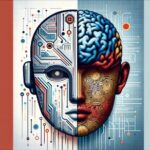Published by Maverick
In the world of digital accessibility, alternative text (alt text) for images stands out as a main and crucial element. In backlist conversion, the alt text is vital to ensure content inclusivity for people with visual impairments. Alt text is not such a tick box or a technical feature; it is the link that connects visually impaired users to the visual aspects of digital content in books and publications.
Over the last few years data science has become a huge driver for businesses and now we have the birth of Artificial Intelligence (AI) in many areas, such as legal, science, and publishing in alternative text writing, etc.
AI application in creating relevant alt text still faces limitations. I will explain the balance between AI capabilities and the indispensable human touch (Actual Intelligence) in drafting the alt text, especially in complex subjects that require subject matter expertise. To add a note here, the subject matter expert is always the author of the content. The author is the person who sources the image, clears its rights and knows exactly the purpose and the nuances of the image to be used in the publication.
Alt Text in accessibility
Alt text is an essential element of the Web Content Accessibility Guidelines (WCAG). The success criteria 1.1.1 states “All non-text content that is presented to the user has a text alternative that serves the equivalent purpose”. This success criteria provides the images, graphs, and other visual content description, making them understandable for screen reader users. It emphasises not just the presence of alt text but its relevance and descriptive quality, ensuring that the content is comprehensible in the absence of visual cues.
Artificial Intelligence in Alt Text creation
Artificial intelligence has been a game changer in many fields, but when it comes to generating alt text for images, it still has a long way to go. Like the spell check, a form of AI, that we use daily, has not been able to totally replace the copy editor in several fields. AI can help identify objects, colours, and basic elements in an image, but it will not replace the actual intelligence, yet. The current situation is training AI to understand and relate these elements to the broader context of the text, especially in specialised or complex subject areas. For instance, in a medical textbook, an image of a cell structure requires not just identification but also an understanding of its relevance to the surrounding content. However, it might be easier in other subjects, such as mathematics.
Actual Intelligence, human touch.
The alt text writing is a process that involves interpretation, contextual/cognitive understanding, and sometimes, a creative touch in describing the image and how it is related to the text of the book.

For example, imagine we have the same image of Big Ben in 3 different books: History book, Tourist attractions in London, and a book about bells and clocks. Should the description be the same? This is when the human element is required to differentiate in the use of the image. AI will simply tell us it is “Big Ben tower next to a parliament building in blue sky.”
The actual intelligence, the human element, becomes indispensable. Actual intelligence can understand nuance, cultural references, and the specific context in which an image is placed within the content of the book. For example, the same image might require different alt text in a children’s storybook compared to a scientific article.
In books and other digital content that covers complex subjects, it is necessary to have subject matter expertise in these fields. An expert in the field can provide better, accurate, relevant descriptions that resonate with the intended audience and are related to the context of the book. This is especially important in educational material, where the accuracy and relevance of alt text can significantly impact the learning outcomes.
Conclusion
While AI offers promising directions for alt text generation, the human touch remains crucial and irreplaceable. As we continue to strive for more inclusive digital environments, the blend of technology and human insight is key. The goal is not just to meet accessibility standards but to ensure that every aspect of digital content, including images, is as accessible and meaningful as the text itself.
Finally, the question then is not whether AI will replace human input in creating alt text but how it can complement human expertise to enhance digital accessibility. As AI technology evolves, its role in supporting and streamlining the alt text creation process will undoubtedly grow. However, the nuanced understanding and contextual interpretation provided by humans will continue to be a cornerstone in the journey toward truly inclusive digital content.
Learn More
Maverick’s Accessibility Program helps publishers comply with legal requirements while creating opportunities for greater discoverability and usability for all readers in the process. Our unique structure allows us to assemble teams with the exact skills needed to support each project. Contact your Maverick representative or info@maverick-os.com for a free consultation.







